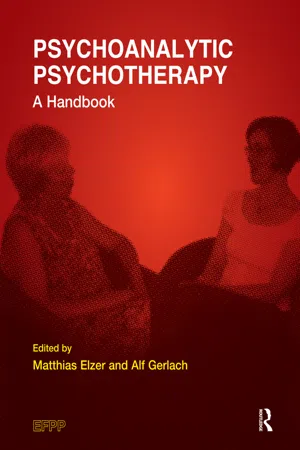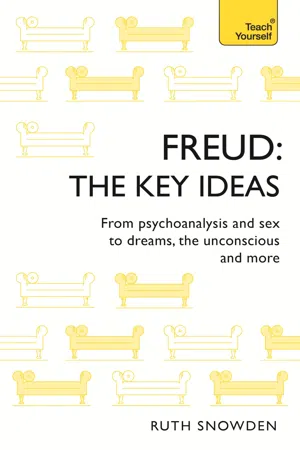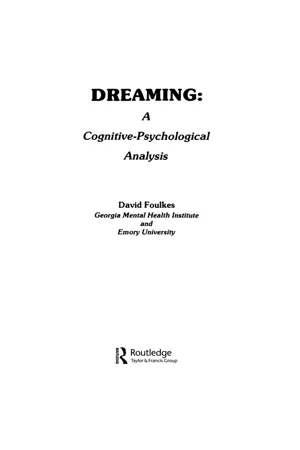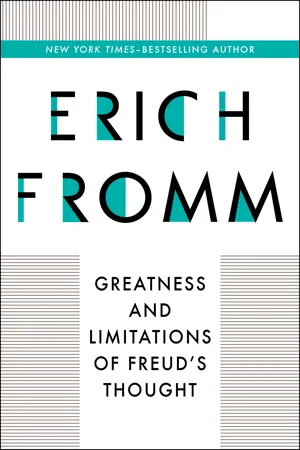Psychology
Theories of Dreams
Theories of dreams in psychology encompass various perspectives on the purpose and meaning of dreams. These theories include Freud's psychoanalytic theory, which suggests that dreams are a window into the unconscious mind, as well as the activation-synthesis theory, which proposes that dreams are a result of random neural activity. Other theories explore the cognitive and emotional functions of dreaming.
Written by Perlego with AI-assistance
Related key terms
4 Key excerpts on "Theories of Dreams"
- eBook - ePub
Psychoanalytic Psychotherapy
A Handbook
- Matthias Elzer, Alf Gerlach(Authors)
- 2018(Publication Date)
- Routledge(Publisher)
CHAPTER FOURDREAMS
Joachim Rothhaupt, Stephan HauThe history of the theory of dreaming and dream researchJoachim RothhauptP sychoanalytical dream research is concerned with three main aspects of dreaming:1. How a dream is generated (generation).2. Whether the dream contents are meaningful (meaning).3. Whether a dream works for psychological or biological needs (function).Freud’s dream theoryThe theory introduced by Sigmund Freud at the beginning of the twentieth century can be seen as a turning point in the scientific investigation of dreams. The psychoanalytic dream theory has deeply influenced most of the current clinical theories on dreaming and, to some extent, modern experimental investigation of dream states as well. In the 1950s, the discovery of REM sleep and of the profile of typical different sleeping states during the night provided the starting point for modern sleep and dream research. This laboratory research has revealed overwhelming new knowledge about the dreaming mind and about the features of the dream state. I will come back to this type of research and to some of the most important findings later. Freud’s “main idea was that dreams serve a function of wish fulfilment. He distinguished between a manifest level of dream content (the dream as it is remembered and reported) and a latent level of dream content that can be inferred by following the associations of the dreamer to the single parts of the dream and by tracing back the different steps of dream work in which the material (infantile material, day residues, etc.) is condensed, displaced, or secondarily revised. The underlying assumption is that the associative chains of the dreamer to every part of the dream will lead to the mental processes that gave rise to the dream and thereby reveal the unconscious (latent) meaning of the dream”. (Hau, 2004, p. 1) - eBook - ePub
Freud: The Key Ideas
Psychoanalysis, dreams, the unconscious and more
- Ruth Snowden(Author)
- 2017(Publication Date)
- Teach Yourself(Publisher)
4 The interpretation of dreamsIn this chapter you will learn:• why dreams are important in psychoanalysis• about dream mechanisms and methods of interpretation• some Freudian symbols and about the origins of dreams.Why dreams are important in psychoanalysisProbably Freud’s greatest contribution to modern thinking is his theory of the unconscious. The positivism that was popular in Freud’s time claimed that people could gain real knowledge of the world and of themselves, and that we had rational control over both. This sort of attitude was reflected throughout scientific thinking, with its insistence on ‘hard facts’, and it even permeated psychology. Freud began to realize that such claims are, at best, delusions, because we are not always aware of what we really think and we are often motivated by unconscious forces within us. He suggested that consciousness actually existed in layers and that there were many psychic processes that went on below the surface, in the world of the unconscious.Dreams were the most immediate and accessible examples of this kind of unconscious thinking – not only did they prove that the unconscious exists but they also provided a means of accessing the information stored there. Freud’s book, The Interpretation of Dreams, really marks the beginning of psychoanalysis proper, in that it proposes the existence of a dynamic unconscious that begins to form in childhood and affects the behaviour of all of us. It does not, however, live up to its claim that Freud had discovered a scientific method for unravelling the meaning of every dream.People have always been interested in dreams, but before Freud they tended to think that the dream somehow arose from outside the dreamer, often as a message from the gods. Thus, dreams were often seen as omens or portents of things that were going to happen in the future. Another theory was that dreams were simply meaningless images caused by indigestion! There was already a great deal of literature concerning dreams in Freud’s day, but he pulled a whole variety of ideas together. He created the first proper theory of dreams and made them into a respectable topic for scientific study. - eBook - ePub
Dreaming
A Cognitive-psychological Analysis
- David Foulkes(Author)
- 2014(Publication Date)
- Routledge(Publisher)
1 What Dreams AreDespite widespread disagreement on how to interpret dreams, there has been general agreement, at least since the publication of Freud’s The Interpretation of Dreams,1 about what dreams are.1. Dreams are Involuntary Symbolic ActsOne of Freud’s major theses about dreaming was that dreams are a form of thought or symbolic activity. The major question of his book was why we think in a different way when we are asleep than we do when we are awake. This is still the central concern of dream psychology. One dimension of difference between dreams and at least some of our waking symbolic behavior is that dreams are involuntary. That is, we are generally surprised on awakening from a dream because we didn’t consciously will that we would dream it. If you think of our waking speech, we generally end up saying something that bears some relationship to what we wantedto say. But dreaming generally doesn’t seem to express any coherent set of wishes or wants at all. At least, we’re generally unable, after having dreamed, to figure out why we dreamed what we did, or what, if anything, we meant to express or establish by having dreamed it.But involuntary ideation is by no means foreign to our waking experience. In fact, in implicitly taking problem solving or reasoning as our model of what waking thought typically is like, we probably greatly over-estimate the voluntary control that we exert over the flow of conscious waking ideation. Often, when we are not occupied with the demands of reality—and sometimes even when we are—unbidden thoughts and images “pop into” consciousness. And, although we may be momentarily bemused or astonished by these thoughts and images, we don’t seriously doubt that we somehow conjured them up. They are our - eBook - ePub
- Erich Fromm(Author)
- 2013(Publication Date)
- Open Road Media(Publisher)
Freud assumed that all dreams are essentially fulfillments of wishes and have the function of preserving our sleep by, as it were, hallucinatory fulfillment. After fifty years of interpreting dreams I must confess that I find this principle of Freud’s only of limited validity. Undoubtedly he made a great discovery when he recognized that dreams are very often the symbolic satisfaction of wishes. But he damaged the significance of this discovery by the dogmatic assumption that this necessarily holds true for all dreams. Dreams can be wish fulfillments, dreams can express mere anxiety, but dreams can also—and this is the important point—express deep insights into oneself and into others. In order to appreciate this function of dreams, some consideration concerning the difference between the biological and psychological functions of sleeping and waking may be useful (see also Fromm, 1951a, chapter 3).In the waking state thoughts and feelings respond primarily to challenge—the task of mastering our environment, changing it, defending ourselves against it. Survival is the task of waking man; he is subject to the laws that govern reality. This means that he has to think in terms of time and space.While we sleep we are not concerned with bending the outside world to our purposes. We are helpless, and sleep, therefore, has rightly been called the “brother of death.” But we are also free, freer than when awake. We are free from the burden of work, from the task of attack or defense, from watching and mastering reality. We need not look at the outside world; we look at our inner world, are concerned exclusively with ourselves. When asleep we may be likened to a fetus or a corpse; we may also be likened to angels, who are not subject to the laws of “reality.” In sleep the realm of necessity has given way to the realm of freedom in which “I am” is the only system to which thoughts and feelings refer.Mental activity during sleep has a logic different from that of waking existence. As indicated before, sleep experience need not pay any attention to qualities that matter only when one copes with reality. If I feel, for instance, that a person is a coward, I may dream that he changed from a man into a chicken. This change makes sense in terms of what I feel about the person, not in terms of my orientation to outside reality.
Learn about this page
Index pages curate the most relevant extracts from our library of academic textbooks. They’ve been created using an in-house natural language model (NLM), each adding context and meaning to key research topics.



